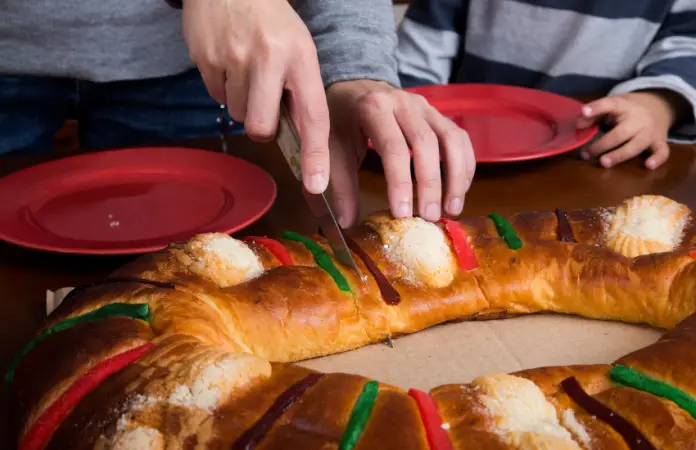There’s no better way to understand a country than by biting into its holiday foods. In Mexico, that means sinking your teeth into the sweet, symbolic goodness of the Rosca de Reyes, Latin America’s answer to king cake in Louisiana and Quebec’s gâteau des rois. Its layers of tradition, candied fruits and hidden surprises make this pastry a wonderful reason to gather and celebrate with family and friends.
This iconic bread takes center stage during Día de los Reyes Magos on Jan 6, the Christian feast day known in English as the Epiphany or Three Kings’ Day, commemorating the Magi’s visit. According to the Gospel of Matthew, the three Wise Men known as Gaspar, Melchor and Balthasar traveled following a bright star to meet the baby Jesus in Bethlehem, bringing with them gifts of gold, frankincense and myrrh.
The evening of Jan. 5 marks the twelfth night of Christmas and is when figures of the three Magi are added to the nativity scene. In Mexico, as in many other Latin American countries, it has traditionally been the Wise Men, not Santa Claus, who bring gifts on Christmas.
What are the origins of the Rosca de Reyes tradition?
The roots of the Rosca de Reyes tradition extend deep into history and are believed to originate with the Roman year-end agricultural festival of Saturnalia. That celebration included eating cake with a coin or other small token hidden inside that bestowed symbolic kingship for a day to the lucky person who bit into the treasure.
This custom evolved in medieval Europe when the Rosca became associated with Epiphany. Whoever found a hidden fava bean in their slice of cake was obligated to treat all the attendees to a round of drinks. The edible treasure was eventually replaced with porcelain to prevent the finder from hiding their responsibility in their belly.
What does the Rosca de Reyes symbolize?
In modern Mexico, the Rosca de Reyes is always oval, symbolizing the infinite circle of God’s love. Candied fruits, such as figs, quince, and cherries, are baked as toppings and symbolize the jewels in the crowns of the Three Wise Men. Hiding the baby Jesus in the bread represents the time when the Holy Family was fleeing from the Massacre of the Innocents – the execution of Bethlehem’s male infants ordered by Herod I.
The excitement on Jan. 6 is tangible as friends gather around a lively table with the Rosca de Reyes at its center. Hot cocoa, milk and coffee add to the delight. The anticipation in the room is palpable as the host slices into the bread. The air is thick with the sweet aroma and every slice is a roll of the dice. Who will be the fortunate guest to choose the slice with a hidden treasure? The room holds its breath while everyone takes a bite. When the figurine emerges, cheers erupt and the party begins.
If you are the one to find it, congratulations! In Mexican tradition, the person who finds the figurine of the baby Jesus becomes responsible for hosting a tamal feast on February 2, Día de la Candelaria or Candlemas Day, commemorating the infant Jesus’ presentation at the Temple in Jerusalem. This makes everyone look forward to gathering again and sharing another delicious meal one month later.
How is Rosca de Reyes made?
The traditional preparation of the Mexican Rosca de Reyes involves a blend of ingredients that contribute to the richness of this holiday bread. The dough is crafted from all-purpose flour, sugar and milk. Butter and eggs create a luscious spongy texture similar to brioche bread. The Rosca’s aroma is enhanced by adding vanilla extract and the zesty brightness of orange blossom water or orange peel.
Topping the Rosca is a combination of softened butter and sugar, creating a sweet and slightly crumbly crust that envelopes the golden bread. The vibrant candied fruits add to the visual feast and all ingredients combine to create a delightful and culturally significant treat.
It is estimated that more than 4 million Roscas de Reyes are sold nationwide every year. The National Chamber of the Baking Industry (Canainpa) indicates that Rosca de Reyes sales generate more than 2.25 billion pesos or 20% of this industry’s annual income.
For expats, embracing the Rosca de Reyes tradition is an invitation to celebrate with neighbors. So next Sunday, seek out the best bakery near you, gather amigos, bite into sugary tradition, and savor the taste of Mexico.
Sandra is a Mexican writer and translator based in San Miguel de Allende who specializes in mental health and humanitarian aid. She believes in the power of language to foster compassion and understanding across cultures. She can be reached at: sandragancz@gmail.com
